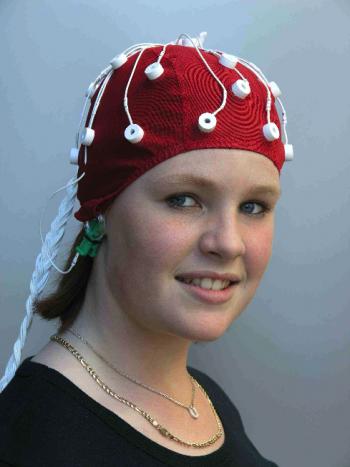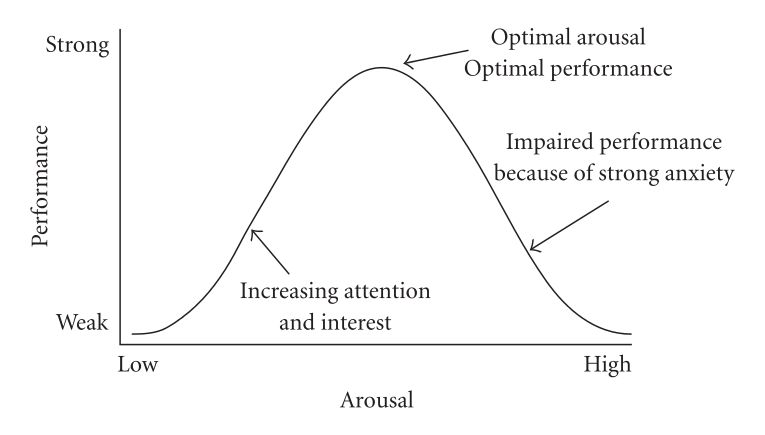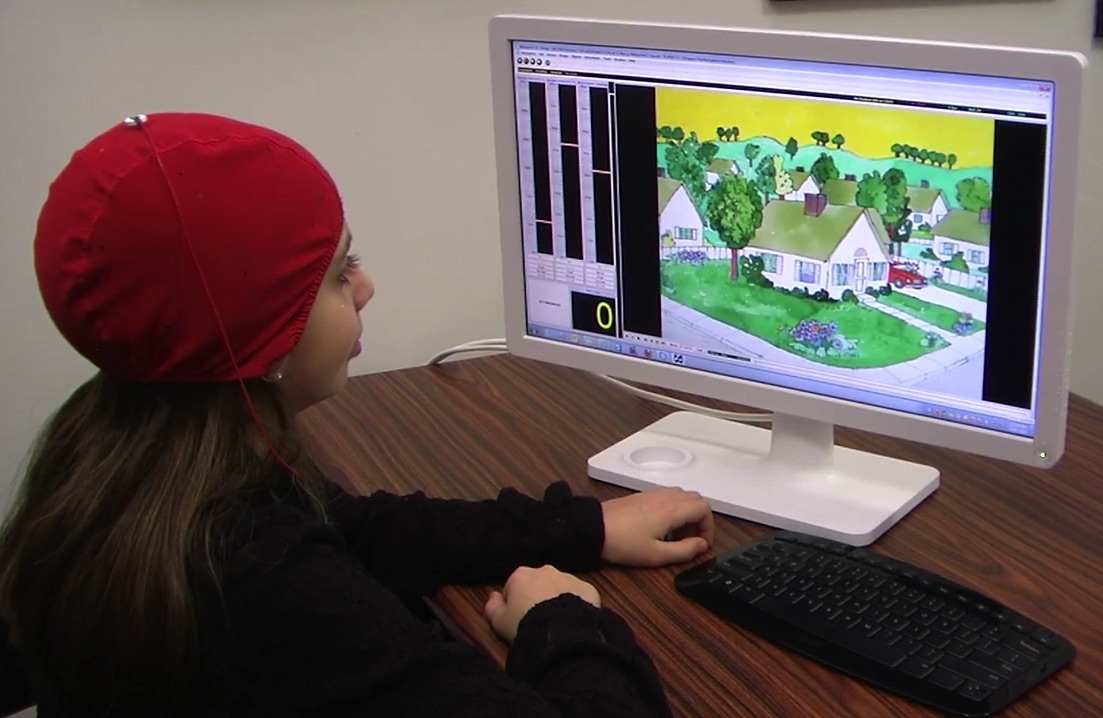Neurotherapy for Treating Autism
Amongst the most common behaviours of children with Autism, is their lack of focus, concentration and compliance and the resulting learning difficulties. Neurotherapy has been extensively researched since 1970 and found to be very effective for ADHD children who have similar issues, and more recently it has been shown to be effective in improving attention and behaviours in children with ASD as well (see studies below in Neurotherapy Bibliography).
Overview of QEEG-guided Neurotherapy for Treating Autism

In the Biomedical abnormalities in Autism Spectrum Disorder page on this website we outline a few of the many neurological abnormalities that have been found in children with ASD. Remember that every child has a unique subset of these abnormalities. Neurological abnormalities are reflected as abnormalities in the "brain's electrical activity", which in turn drive the behaviours observed in children with Autism. QEEG is a non-invasive tool to statistically compare the brainwaves of an individual to those brainwaves stored in a database of typically developing/functioning people of the same age (age range: 3 to 79 years).
The statistical differences are then represented in coloured maps, often called Brainmaps. Note that this process is very different to the conventional EEG examination performed by a Neurologist, who visually examines the electrical brainwaves for "epileptiform", a pattern of infividual waves suggestive of epilepsy.
Brain electrical activity is divided into bands of individual frequencies called Hertz (Hz for short). Although all brainwave frequencies are present in the EEG, it is the excesses or deficits at specific locations that are associated with abnormal behaviours.
Delta waves (1-4 Hz) are normally seen predominantly in infants and in deep sleep. Excesses in delta suggest low blood flow and significant brain dysfunction, lethargy, drowsiness, and/or cognitive impairment. Deficits suggest sub-optimal serotonin neuromodulation, and is one of the patterns associated with flat mood and depression.
Theta waves (4-8 Hz) are normally seen in young children. Excesses in theta are associated with reduced blood flow and is frequently seen in children and adults with attention deficits disorder and learning difficulties.
Alpha waves (8-13 Hz) are normally produced in the resting state of the brain. They are normally associated with relaxation, meditation and self-awareness. Excessive alpha can be a sign of learning difficulties, attention deficits, emotional instability and/or depression.
Beta waves (13-21 Hz) and High Beta(21-30 Hz) waves Are normally associated with alertness and information processing. Excess beta waves at frontal sites is associated with anxiety, excitability, hyper-vigilance, irritability and poor sensory integration. Global excesses may be from environmental toxins which cause cortical irritability and scramble information processing. Deficits suggest a lack of electrical power and are associated with reduced information processing capacity.

The graph on the left represents how for each frequency there is an optimum power level for optimum performance. Although, as a group, there are common denominators in the brainwaves and behaviours of children with Autism, there are also individual differences.
Hence, Neuroscientists and clinicians do not look for patterns in the brain maps that will identify Autism, as there is no such single pattern. Instead, we look for statistically recognisable features that have been associated with specific behaviours. There are thousands of studies that have associated excesses or deficits in brainwaves at specific locations, with various behavioural manifestations, such as: attention deficits, learning difficulties, receptive or expressive language deficits, depressed mood, anxiety, OCD, ODD and other behavioural deficits.
The Brain maps below represent brain electrical activity as "differences from normal". Grey and one colour on either side of grey on the scale are in the normal range. The cooler blue colours progressively indicate deficits, while the warmer red colours progressively indicate excesses. To keep things simple, we are only looking at differences in power levels in frequency bands here. In research and clinical practice, we also look at differences in individual frequencies and coherence (connectivity) between different areas of the brain, and asymmetries, left to right and back to front. All of which gives us information about brain "function". The first brainmap below is that of a typically developing child with no disorders and the next four brainmaps (Cases 1-4) demonstrate how different the brain of children with ASD can be.





QEEG and Neurotherapy for ASD Research
Here are links to a few of the many studies studies regarding QEEG in Autism Spectrum disorder:
- BRAIN CONNECTIVITY IN AUTISM. This publication, from Frontier in Human Neuroscience, contains a series of 15 separate studies on QEEG in Autism Spectrum Disorder
- QEEG characteristics and spectrum weighted frequency for children diagnosed as autistic spectrum disorder
- EEG power and coherence in autistic spectrum disorder.
- On the Application of Quantitative EEG for Characterizing Autistic Brain: A Systematic Review.
- Autism and EEG phase reset: deficient GABA mediated inhibition in thalamo-cortical circuits.
- Resting state EEG abnormalities in autism spectrum disorders
- QEEG-guided neurofeedback
- Brainmaps highlight Autism Disorders
- QEEG-Guided Neurofeedback for Autism: Clinical Observations and Outcomes
- A review of the use of EEG connectivity to measure the neurological characteristics of the sensory features in young people with autism
- Is functional brain connectivity atypical in autism? A systematic review of EEG and MEG studies
- Name recognition in autism: EEG evidence of altered patterns of brain activity and connectivity
- Toward an Interdisciplinary Understanding of Sensory Dysfunction in Autism Spectrum Disorder: An Integration of the Neural and Symptom Literatures
- Neural Correlates of Sensory Hyporesponsiveness in Toddlers at High Risk for Autism Spectrum Disorder
- EEG Coherence Patterns in Autism: An Updated Review
- Standard Electroencephalography in Clinical Psychiatry: A Practical Handbook
- Brain Connectivity in Autism Spectrum Disorder
- A review of the use of EEG connectivity to measure the neurological characteristics of the sensory features in young people with autism
Neurotherapy for ASD

In the Early 1970s Prof. Barry Sterman at UCLA and later Prof. Joel Lubar at Tennessee University developed Neurotherapy, Neurofeedback (NF), or EEG biofeedback. This is a technique that specifically targets EEG anomalies and attempts to retrain them by learning through operant conditioning. This is the same process as that used in intensive early intervention and is similar to ABA therapy.
This web page provides an overview of Neurotherapy research and its effectiveness in permanently redressing ADHD symptoms in over 80% of subjects. Neurotherapy can also improve attention deficits in autistic children, enabling them to respond faster to intensive Behaviour Intervention.
Ordinarily, we cannot directly influence our brainwave patterns because we lack awareness of them. However, when you can see your brainwaves on a computer, it gives you the ability to influence and change them. This is the basis of "Biofeedback". We are literally reconditioning and retraining the brain. At first, the changes are short-lived, but the changes gradually become more enduring. With continuing EEG biofeedback, coaching, and practice, we can usually help most people train their brainwave patterns towards normal, enhancing attention, cognitive flexibility and mood control.
Neurotherapy is based on the principles of learning theory, ABA therapy and operant conditioning. Namely, when we reward a behaviour, we increase the likelihood of that behaviour being repeated. During a Neurotherapy session, the person has a sensor placed at a specific location where we want to improve function. this sensor is connected to an electroencephalographic device which sends the Brain's electrical activity at that location to a computer software. The software extracts the specific frequencies that we want to reward and/or suppress and displays them as levels on bar charts on the left of the screen. Typically, reward criteria is met when the slow waves are below its set threshold and the fast waves above its set threshold.
When the reward criteria are met the child is rewarded for producing the brainwave pattern that we want to promote. This increases the likelihood of the appropriate brainwaves being produced more frequently. The visual and auditory reward feedback may be in the form of a video which will play at full intensity and normal sound level or PACMAN will move, or "Space invader game" will allow firing of lasers.
Neurotherapy has been practised since the 1970s. There are hundreds of studies attesting to the efficacy of Neurotherapy for attention deficit disorders. More recently these studies have been extended to treating children with ASD. Hundreds of thousands of individuals and families impacted by various mental health and/or neurological conditions have benefited greatly from this powerful, effective, established, and proven intervention. Neurotherapy is non-invasive and creates lasting results, in stark contrast from the outcomes derived from pharmaceutical treatment for a wide variety of conditions. The international Society for Neurofeedback Research estimates that over 20,000 clinicians, world-wide are using this technology. The represented professions are inclusive of: Psychiatry, Psychology, Social work, Nursing, Neurology, Paediatrics, Rehabilitation medicine, Physical therapy, Occupational therapy, Naturopathic medicine, Speech pathology, Chiropractic, Child and adolescent Psychiatry, and Family Medicine. In Europe it is often used by Medical professionals, and the research is frequently published by Medical professionals working from hospital settings.
Studies concerned with Neurofeedback for Autism
Here are links to a few of the many studies studies regarding Neurotherapy in Autism Spectrum disorder:
- Baruth, J., Casanova, M., El-Baz, A., Horrell, T., Mathai, G., Sears, L., Sokhadze, E. (2010). Low-frequency repetitive transcranial magnetic stimulation modulates evoked gamma frequency oscillations in autism spectrum disorder. Journal of Neurotherapy, 14(3), 179–194.
- Coben, R. Middlebrooks, M., Lightstone, H. and Corbell, M. (2018) Four Channel Multivariate Coherence Training: Development and Evidence in Support of a New Form of Neurofeedback. Front. Neuroscience 12: 729. PMID: 30364276
- Coben, R., Mohammad-Rezazadeh, I., Cannon, R. (2014). Using quantitative and analytic EEG methods in the understanding of connectivity in autism spectrum disorders: a theory of mixed over- and under-connectivity. Frontiers in Human Neuroscience 8:45. doi: 10.3389/fnhum.2014.00045.
- Coben, R., & Myers, T. E. (2010). The relative efficacy of connectivity guided and symptom based EEG biofeedback for autistic disorders. Applied Psychophysiology & Biofeedback, 35(1), 13–23.
- Coben, R., & Pudolsky, I. (2007). Assessment-guided neurofeedback for autistic spectrum disorder. Journal of Neurotherapy, 11(1), 5–23.
- Coben, R., (2007). Connectivity-guided neurofeedback for autistic spectrum disorder. Biofeedback, 35(4), 131–135.
- Coben, R., Sherlin, L., Hudspeth, W. J., McKeon, K., & Ricca, R. (2014) Connectivity-Guided EEG Biofeedback for Autism Spectrum Disorder: Evidence of Neurophysiological Changes. Journal of NeuroRegulation, 1(2) 109-130.
- Drysdale, M,T,B., Martinez, Y, J., Thompson, L. (2012). The effects of humorous literature on emotion: A pilot project comparing children with asperger’s syndrome before and after neurofeedback training and controls. Journal of Neurofeedback.
- Friedrich, E., Sivanathan, A., Lim, T., Suttie, N., Louchart, S., Pillen, S., Pineda, J. (2015). An effective neurofeedback intervention to improve social interactions in children with autism spectrum disorder. Journal of Autism & Developmental Disorders, 45(12), 4084-4100. doi: 10.1007/s10803-015-2523-5
- Frye, R., Rossignol, D., Casanova, M., Martin, V., Brown, G., Edelson, S., Coben, R., Lewine, J., Slattery, J., Lau, C., Hardy, P., Fatemi, S., Folsom, T., MacFabe, D., Adams, J. (2013). A review of traditional and novel treatments for seizures in autism spectrum disorder. Findings from a systematic review and expert panel. Public Health 1:31. doi: 10.3389/fpubh.00031
- Goodman, M. S., Castro, N., Sloan, M., Sharma, R., Widdowson, M., Herrera, E., Pineda, J. A. (2018). A Neurovisceral Approach to Autism: Targeting Self-Regulation and Core Symptoms Using Neurofeedback and Biofeedback. NeuroRegulation 5(1), 9-29.
- J. R. Evans (Ed.), Handbook of Neurofeedback. Binghampton, NY: Haworth Medical Press. "The whole Book"
- Jarusiewicz, G. (2007). Use of neurofeedback with autistic spectrum disorders. Chapter in J. R. Evans (Ed.), Handbook of Neurofeedback. Binghampton, NY: Haworth Medical Press, pp. 321–339.
- Jarusiewicz, B. (2002). Efficacy of neurofeedback for children in the autistic spectrum: A pilot study. Journal of Neurotherapy, 6(4), 39–49.
- Knezevic, B., Thompson, L., & Thompson, M. (2010). Pilot project to ascertain the utility of Tower of London Test to assess outcomes of neurofeedback in clients with Asperger’s Syndrome. Journal of Neurotherapy, 14(3), 3–19.
- Kouijzer, M. E. UJ., de Moor, J. M. H., Gerrits, B. J. L., Buitelaar, J. K., & van Schie, H. T. (2009). Long-term effects of neurofeedback treatment in autism. Research in Autism Spectrum Disorders, 3(2), 496–501.
- Pineda J. A., Brang D, Hecht E, Edwards L, Carey S, Bacon M, Futagaki C, Suk D, Tom J, Birnbaum C, Rork A.(2008). Positive behavioral and electrophysiological changes following neurofeedback training in children with autism. Research in Autism Spectrum Disorders, 2, 557–581.
- Scolnick, B. (2005). Effects of electroencephalogram biofeedback with Asperger’s syndrome. International Journal of Rehabilitation Research, 28(2), 159–163.
- Sichel, A. G., Fehmi, L. G., & Goldstein, D. M. (1995). Positive outcome with neurofeedback treatment of a case of mild autism. Journal of Neurotherapy, 1(1), 6064.
- Sokhadze, E., Baruth, J., El-Baz, A., Horrell, T., Sokhadze, G., Carroll, T., Tasman, A., Sears, L., Casanova, M. (2010). Impaired error monitoring and correction function in Autism. Journal of Neurotherapy, 14(2), 79–95.
- Sokhadze, E. M., Casanova, M. F., El-Baz, A. S., Farag, H. E., Li, X. & Wang, Y. (2016). TMS-based Neuromodulation of Evoked and Induced Gamma Oscillations and Event-related Potentials in Children with Autism. NeuroRegulation, 3.(3), 101-126.
- Sokhadze, Guela & Casanova, Manuel & Kelly, Desmond & Casanova, Emily & Russell, Brook & Sokhadze, Tato. (2017). Neuromodulation Based on rTMS Affects Behavioral Measures and Autonomic Nervous System Activity in Children with Autism. NeuroRegulation. 4. 65-78. 10.15540/nr.4.2.65.
- Sokhadze, E., El-Baz, A., Tasman, A., Sears, L., Wang, Y., Lamina, E., Casanova, M. (2014). Neuromodulation integrating rTMS and neurofeedback for the treatment of autism spectrum disorder: an exploratory study. Applied Psychophysiology & Biofeedback, 39(3-4), 237-257. doi: 10.1007/s10484-014-9264-7
- Steiner, N., Frenette, E., Hynes, C., Pisarik, E., Tomasetti, K., Perrin, E., Rene, K. (2014). A pilot feasibility study of neurofeedback for children with autism. Applied Psychophysiology & Biofeedback, 39(2), 99-107. doi: 10.1007/s10484-014-9241-1
- Wang, Y., Sokhadze, E. M., El-Baz, A. S., Li, X., Sears, L., Casanova, M. F., Tasman, A. (2015). Relative power of specific EEG bands and their ratios during neurofeedback training in children with Autism Spectrum Disorder. Frontiers in Human Neuroscience, 9, 723.
- FOR A FULL NEUROTHERAPY BIBLIOGRAPHY LOOK UP THE ISNR WEBSITE




